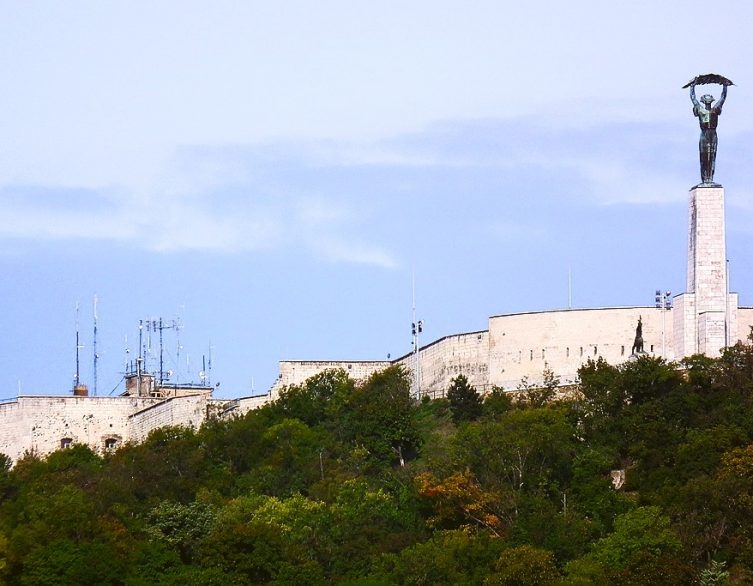A Historic Change Atop Gellért Hill: The Liberty Statue Gets a Cross

Standing majestically atop Gellért Hill, overlooking the beautiful Danube and the sprawling cityscape of Budapest, the Liberty Statue has been an iconic symbol for decades. But as you plan your visit to this breathtaking viewpoint, you’ll witness something unprecedented – a significant transformation that has sparked passionate debates across Hungary.
The Monument That Tells Budapest’s Story
The Liberty Statue, known locally as the Szabadság-szobor, has always been more than just a tourist attraction. This towering female figure holding a palm branch has watched over Budapest since 1947, becoming one of the city’s most recognizable landmarks. Originally designed by sculptor Zsigmond Kisfaludi Strobl, the statue stands over 14 meters tall on a pedestal that rises more than 20 meters above the Citadella.
For visitors exploring Budapest’s rich history, this monument represents layers of the city’s complex past. The statue has witnessed the Soviet era, the fall of communism, and Hungary’s journey into the European Union. Now, it’s experiencing perhaps its most controversial chapter yet.
A Cross Emerges from Controversy
Despite months of protests and heated public debate, workers are putting the finishing touches on a significant addition to the Liberty Statue – a cross on its pedestal. This change, part of the massive renovation project at the Citadella, has divided opinions across Hungarian society.
The National Hauszmann Program, responsible for the renovation, explained their vision clearly. They want to place a cross on the pedestal as “the most important symbol of 1100 years of Hungarian statehood, Western Christianity, and European cultural heritage.” The symbolism is particularly pointed – this same pedestal once held a statue of a Soviet soldier, designed by Stalinist architect Boris Jofan.
Why This Matters to Your Budapest Experience
As a visitor to Budapest, you’re witnessing history in the making. The addition of the cross represents Hungary’s ongoing dialogue about its identity, heritage, and place in Europe. When you climb up to the Citadella or take the scenic route through Gellért Hill, you’re not just seeing a tourist site – you’re experiencing a living monument that continues to evolve.
The controversy surrounding this change reflects deeper conversations about religious symbols, artistic integrity, and national identity that resonate throughout Central Europe. Even prominent figures who typically support the government, including András Bencsik from the pro-government Demokrata newspaper, voiced opposition to the plan.
Best deals of Budapest
The Legal Drama Behind the Scenes
What makes this story particularly fascinating is the legal complexity that unfolded. The descendants of the original sculptor, Zsigmond Kisfaludi Strobl, held copyright protection until 2046, giving them potential power to block the modification. This led to months of negotiations and even consideration of new legislation to override copyright concerns.
The artist’s heirs initially opposed the change, arguing that adding a cross would create an entirely new artwork rather than simply modifying the existing one. However, as the project progressed, the family eventually stepped back from the fight, allowing the transformation to proceed.
What You’ll See Today
When you visit the Liberty Statue now, you’ll notice scaffolding and construction netting still surrounding parts of the monument. The cross is taking shape beneath these coverings, representing the final phase of this controversial addition. The entire Citadella renovation project, worth over 20 billion forints, aims to transform this historic fortress into a modern cultural and tourist destination.
Planning Your Visit
The ongoing construction doesn’t diminish the spectacular views from Gellért Hill. The panoramic vistas of Budapest remain breathtaking, stretching across the Danube to the Parliament building, Buda Castle, and the sprawling Pest side of the city. The best times to visit are during sunrise or sunset when the golden light bathes the entire cityscape.
Consider combining your visit to the Liberty Statue with exploration of the nearby Gellért Thermal Baths or a walk through the Cave Church. The area offers multiple attractions that showcase different aspects of Budapest’s character, from its thermal spring heritage to its spiritual traditions.
A Monument in Transition
The Liberty Statue’s transformation reflects Budapest’s own evolution as a city that honors its past while defining its future. Whether you support or question the addition of the cross, there’s no denying that you’re witnessing a significant moment in the monument’s history.
As construction wraps up and the scaffolding comes down, visitors will see the completed vision – a Liberty Statue crowned with a cross, standing as a new symbol of Hungary’s interpretation of its Christian heritage and European identity. This change ensures that your visit to one of Budapest’s most famous landmarks will be unlike any previous tourist’s experience.
The debate may continue, but the cross is becoming reality, adding another chapter to the rich story that unfolds across Budapest’s skyline. When you stand before this transformed monument, you’ll be part of its ongoing narrative – a witness to how cities and their symbols continue to evolve in our modern world.
Related news
Related attractions




















